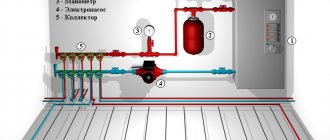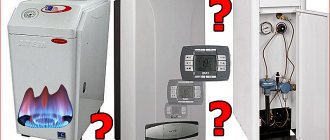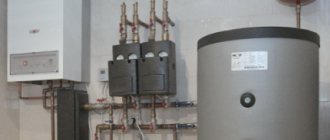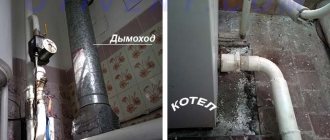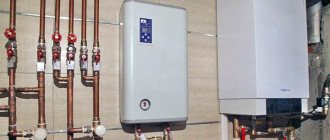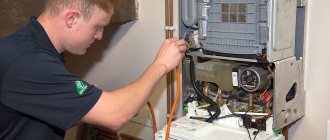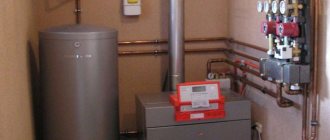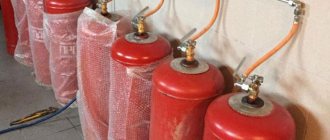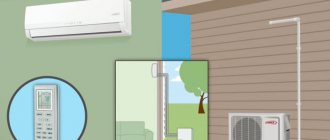Video description
In our video we’ll talk about heating in a private country house. Our guest is the author and presenter of the Teplo-Voda channel Vladimir Sukhorukov:
Oil radiator
Considered uneconomical - critics argue that it should not be used as a heating device due to high energy consumption and low output. But it is this type of device that has one of the highest efficiency - about 98%. That is, it converts almost all electrical energy into heat (the law of conservation of energy has not yet been canceled), and those minor losses of 2% are due to the resistance of the internal walls of the radiator to the coolant. Yes, it is inertial - it takes a long time to warm up, but it also takes a long time to cool down.
Another drawback is that it takes a long time to warm up the room.
But this is a property of all batteries, including water heating, in which the main method of heat transfer is natural convection, and it proceeds slowly.
The main disadvantage is the “rough” power control and the use of mechanical thermostats. And such inaccurate control of temperature conditions makes an oil radiator ineffective when trying to optimize the cost of heating with electricity in a private home. And yet, it has a rather high body temperature when operating at full power, which is dangerous if there are small children in the house.
There are models of oil radiators that can be hung on the wall Source b-sector.ru
Fan heater
It is often written about a fan heater that it burns oxygen. But “oxygen combustion” is nothing more than an oxidation (combustion) process, and the maximum that can burn at a fairly low temperature of the coil is organic dust in the air. Therefore, it is incorrect to talk about burning oxygen (after all, it’s not wood that burns) since this insignificant volume must be replenished as a result of mandatory ventilation of the room.
The efficiency of such a device is slightly lower than that of an oil radiator (part of the electricity is spent on operating the fan), but it is not very different, considering that the power of the fan motor itself is small (about 50 W out of a total of 1 or 2 kW). The advantage is that the room warms up very quickly. Disadvantages are a constant noise level (albeit insignificant) and dust transfer throughout the room. And the main drawback of these household appliances is manual power adjustment and the illusory possibility of creating an automated heating system based on fan heaters
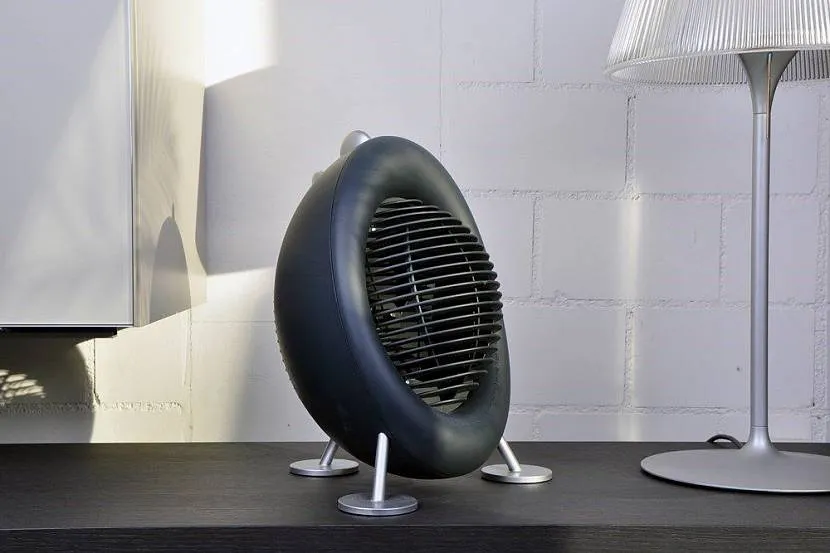
A fan heater is the most compact heating device, and it is great for heating a small area Source romb.ua
Therefore, it is necessary to emphasize once again that the main reason why some types of electric heaters are not suitable for heating a home is not the efficiency (almost all of them are above 95%), but the impossibility of automating system control. It is this factor that does not allow optimizing the operation of the heating system, and without this it is impossible to heat a house with electricity cheaply.
Electric Heating Options
Modern technologies and the development of a consumer society offer us a great variety of ways to increase the temperature of a room using electricity. But not everyone will be able to heat their home on their own.
Underfloor heating

A detail that gives real comfort to a home is used for complete heating of certain rooms. The principle of operation of an electric floor heating system is simple: a heating element and a cable to a source of electricity are routed under the floor covering. Electric current flows, the heating element heats up, and heats the air around it. Natural air circulation occurs according to the laws of physics and the difference in the mass of cold and warm gases. The room is heated. But it is worth considering a significant drawback - the impossibility of reaching a really high temperature, because the floor must remain suitable for movement, and it is not surprising that its coating will be damaged by high temperatures. Therefore, heated floors are used in combination with several heat sources.
Convectors

A simple, reliable, convenient, unpretentious design of electric heating, capable of independently heating rooms. It takes its name from the principle of operation - convection, the movement of gases with different temperatures in space, when warm gas tends upward and cold gas downward. Conventional central heating batteries in apartments work in a similar way.
Oil heating

A very popular electric heating system for the home - almost everyone has it. An oil heater has a certain number of positive qualities. Undeniable qualities ensured its popularity in the Russian market. The principle of operation is as primitive as possible: the heating element heats the oil inside the structure and produces a stable source of heat.
The advantages are obvious:
- The system is small in size, fits perfectly in any room, and fits into any interior.
- Simple horizontal movement is provided by small wheels.
- It works absolutely silently.
- Safe to use, no possibility of burns.
- Low price models. The heater does not dry the air.
Among the disadvantages is the illusory possibility of heating large rooms with one model. High inertia is both a plus and a minus.
Air conditioner
The air conditioner in the minds of the majority of people is a device that cools an office, cafe, restaurant, room. But modern technologies have long gone beyond lowering the room temperature; today air conditioners can and are successfully used as electrical heating systems for rooms. The heating method is extremely primitive. The device pumps air into the room, the liquid inside the air conditioner condenses, moving heat. Heating occurs with boiling freon. Freon gas condenses due to high pressure. The advantages are known – a pleasant flow of hot air at any time with a flexible control system. But the main disadvantage covers all the advantages - the best air conditioners operate in a heating system only when the ambient temperature in the room is not lower than fifteen degrees.
Having a certain number of disadvantages, electric home heating systems certainly benefit from versatility of use.
Efficient methods of heating with electricity
Heating with electricity in a private house has the main advantages over all others - these are simple and accurate methods for monitoring and regulating the operation of all components and elements. Even the sensors and display of information about operating modes are more accurate than those of equipment using other types of energy carriers.
Individual electric heating of a private house has three options for heating systems:
- autonomous water heating systems based on electric boilers:
- use of infrared ceramic heaters;
- electric convectors with electronic thermostats.
All these systems can be adapted into a smart home system and controlled remotely.
Types of electric boilers
It should be mentioned that wall-mounted and floor-mounted electric boilers are available.
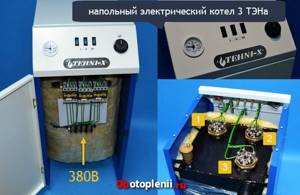
Also, in addition to heating element electric boilers, more efficient electric boilers have found widespread use: electrode and induction electric boilers.
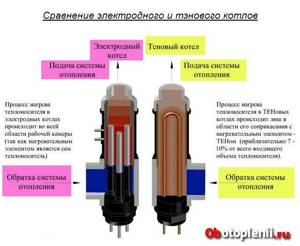
Heating with electric boiler
This is a classic diagram of an autonomous heating system. There are two options for heating the coolant - indirect and direct.
Electric boilers of indirect heating come in two types: heating elements and induction.
The design and principle of operation of heating element boilers are quite simple - there is a heating coil enclosed in a sealed metal shell with a dielectric heat-conducting filler, the heat from the spiral through the filler is transferred to the surface of the heating element shell, with which the heating system coolant is in contact.
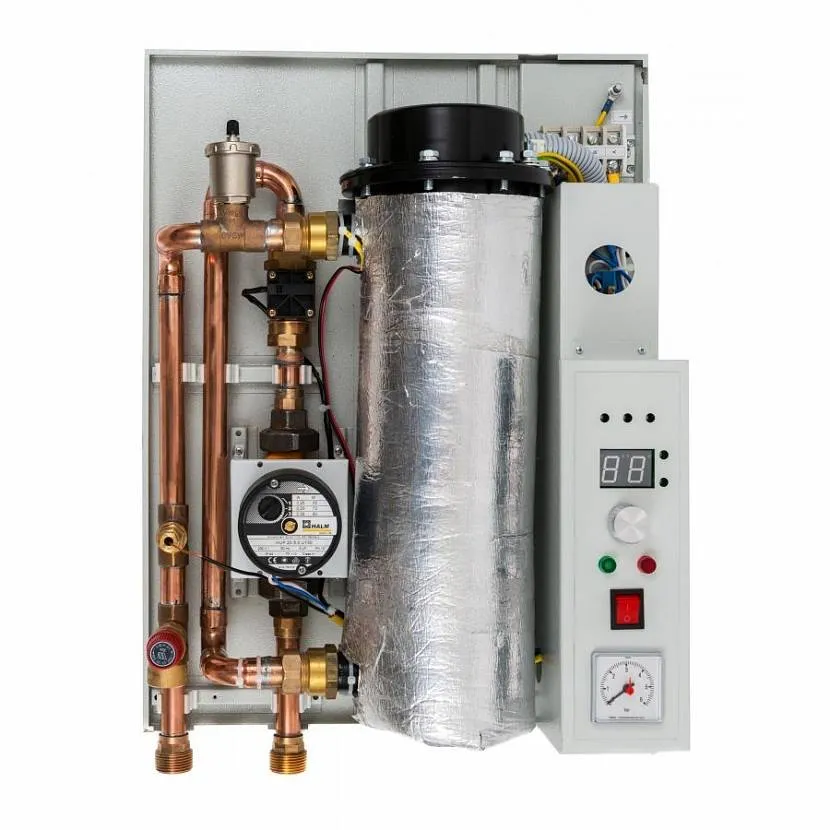
This is what the “filling” of a 9 kW heating element boiler looks like, which, despite its compact size, is capable of heating a house of 100 m2 Source mirvera.ru
Induction boilers have appeared for domestic heating systems relatively recently. Their operating principle lies in the property of metals to heat up under the influence of an alternating magnetic field. The heating element itself is an inductive coil with a ferromagnetic alloy core, through the “secondary winding” of which the coolant passes.
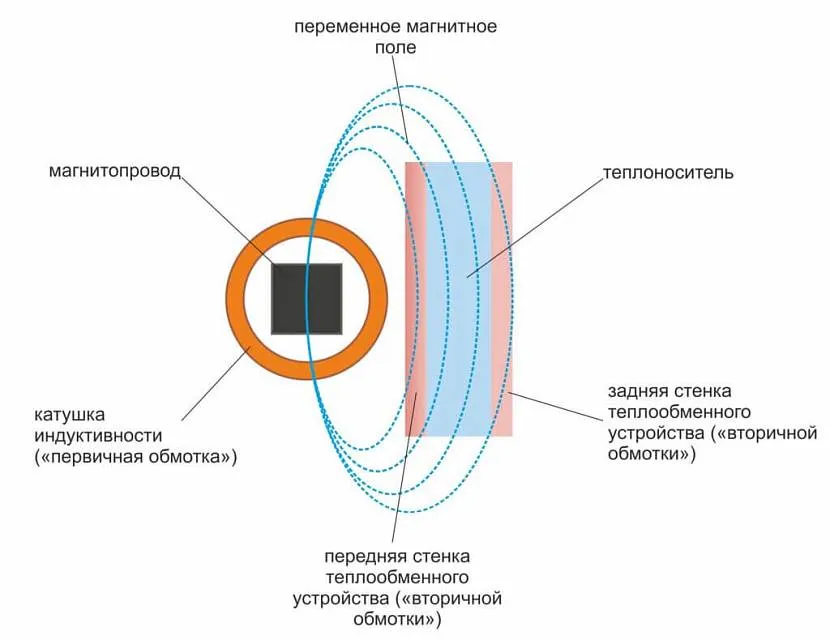
Scheme of operation of an induction heater Source josri.ru
The peculiarity of direct heating electric boilers is that water not only acts as a coolant, but is also part of the electrical circuit - alternating current passes through it between the electrodes. Hence the name of the boilers - electrode.
Each type of boiler has its own disadvantages. Heating elements form scale, which leads to a decrease in the useful power and service life of the boiler. Induction ones are quite expensive, bulky and have “stepped” power adjustment. Electrode ones have strict restrictions on the quality and composition of water, which must have a certain specific electrical resistance to alternating current.
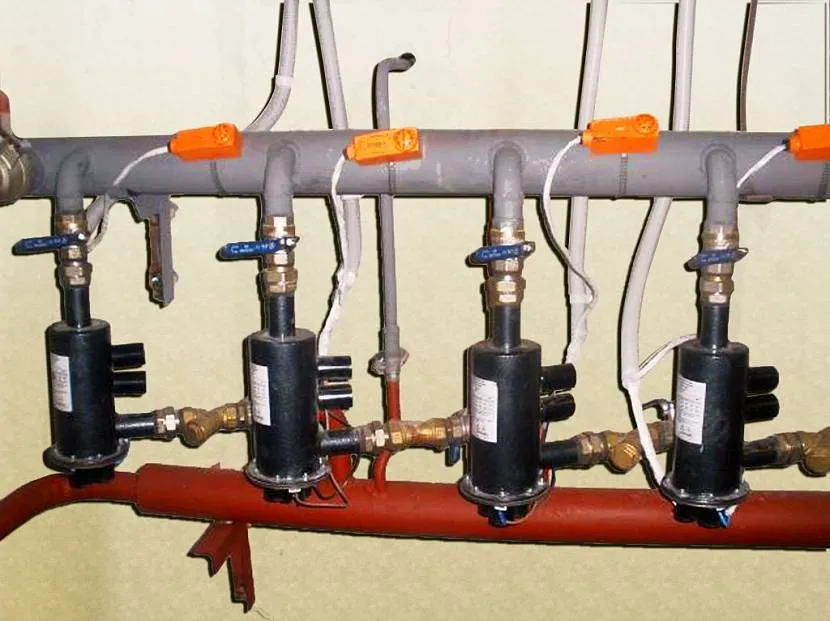
A cascade of four electrode boilers for heating a large house Source obriy-ua.com
Well, the main disadvantage of heating a country house with an electric boiler is the presence of the coolant itself and the “bulky” circulation system of pipes and radiators. Setting up such a system is costly, and the efficiency compared to direct electric heaters may be lower if circulation pumps are used.
What determines the actual power consumption?
The most significant power consumption of an electric heating boiler depends on:
- Operating conditions . Namely, on the desired temperature regime (a decrease in temperature by 1°C implies up to 5% savings), constancy of residence in the house and regulation of indicators during sleep or absence of the owners of the house.
- Technical condition of the boiler . Namely, its heating elements (tubular electric heaters). When using hard, untreated and constantly replaced water as a coolant, scale forms on heating elements, which reduces efficiency from 99% to 90.80 and even 70%. To heat the coolant to the previous temperature through a layer of scale, the electric boiler requires more energy and time.
- Equipment . The circulation pump and advanced automation consume from 60 to 150 W. However, these are not so significant values against the background of already expensive operating costs.
- Automation functionality . Advanced modern automation has several operating modes, more competently controls the switching on and off of heating elements, the operation of the circulation pump, smoothly regulates the temperature, and allows you to set hysteresis values. Electric boilers in the middle and higher price categories are often equipped with the ability to program the operating mode, which significantly affects consumption.
This is interesting: DIY cable wiring diagrams: Step-by-step instructions
Video description
Video about infrared heaters:
There are three fundamentally different types of infrared heaters:
- reflectors in which the filament coil is enclosed in a quartz glass bulb;
- panel - a heating element is “soldered” in a ceramic monolithic slab;
- film - with carbon coating on a polymer film.
Heating a house with electricity of the first type refers to heaters operating in the short-wave range of infrared radiation.
Such devices can be used as an additional heater, but not as a basic element of the heating system of a private house with electricity.
Disadvantages - the lowest efficiency (due to the visible part of the radiation), lack of precise temperature control and high case temperature.
The second type of device operates in the soft long-wave range. The maximum temperature of the ceramic panel does not exceed 90°C, but on the body it is even lower. There are two types of control - mechanical and electronic thermostat. The first option involves manual control and its accuracy is low. Using electronic thermostats, you can set the temperature with an accuracy of 1°C.

The infrared panel is so safe that it can be hung on wooden walls Source centr-tepla.in.ua
Film heaters are the most efficient. They are usually used as part of underfloor heating, but in principle they can be mounted in walls or on the ceiling. But it is the installation as part of the floor covering that most closely corresponds to the correct and uniform heating of the room. Operation is controlled automatically using a temperature sensor-thermostat pair.
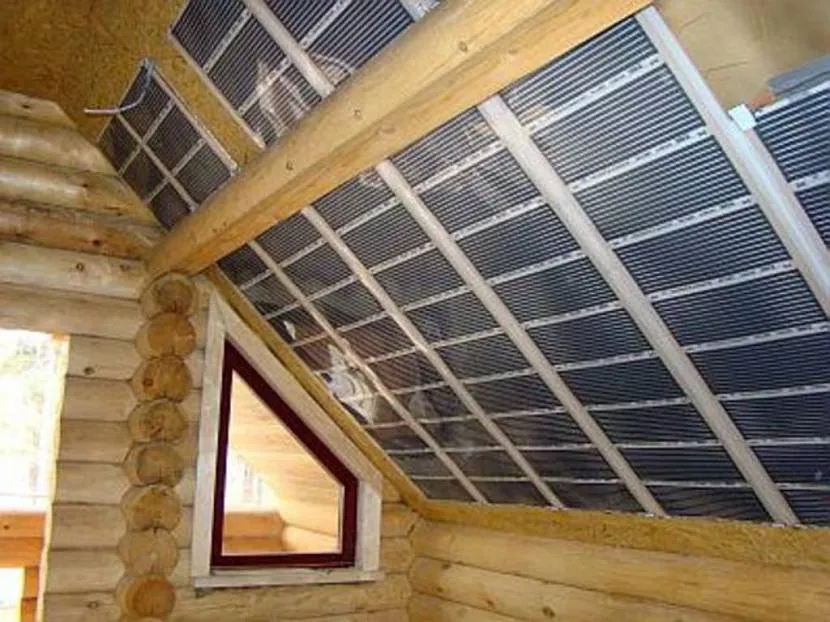
If there is not enough space on the floor, then the film heater can be mounted on any free plane Source otdelka-expert.ru
No. 8. Warm floors for a country house
Warm floors will create the most comfortable conditions for staying in a country house. To install an electric heated floor, the following are used:
- cable , which is laid in waves, stripes or zigzags in the necessary parts of the room;
- infrared film, which works on the principle of infrared heaters and is easy to install. It is even used for arranging “warm ceilings” and “warm walls”.
Warm floors are called a more or less economical method of heating due to the presence of an automatic control system and proper heat distribution, but still such heating cannot be called cheap. In operation, a film floor will cost less , but the film is more expensive than electrical cables.
The main advantages of electric heated floors include:
- ease of installation and operation;
- uniform heating of the entire room;
- safety;
- durability;
- the ability to adjust the temperature down to 0.1 0 C;
- no need to allocate space for a boiler, radiators or heaters.
If the area of a country house is large, then it is impossible to consider a warm floor as an independent source of heating.
Convectors
In appearance, convectors are very similar to ceramic panel heaters, but inside the metal case there is an “open” heating element enclosed inside a plate radiator. The fundamental difference is in the heating method - cold air enters the case through the bottom row of holes, comes into contact with the radiator, heats up and exits through the top row of holes.
The convector housing not only serves as protection for the heating element, but also increases the speed of the upward flow. Due to this, with the same power, the room is heated faster than from a water heating battery.

The stylish convector panel looks great in a modern interior Source teplo-vsem.ru
Like ceramic panel heaters, there are two types of thermostats - mechanical and electronic. And it is the electronic control of the work that ensures the accuracy of adjustment and the ability to work in several modes:
- individual, with manual control, used for heating a separate room;
- group, operation of several devices under the control of one (common) thermostat, which ensures uniform heating of a large area or the same heating mode for several rooms;
- intelligent, control using a remote control, connection to a GSM module and control using standard commands from a remote terminal (mobile communications, Internet), connection to a router and control via a local network and/or the Internet.
Cost of electricity in the kitchen
If you don't have gas, you'll have to cook with electricity. Modern electric stoves are highly efficient, but they also consume 5 to 7 kilowatts of electricity per hour at full power.
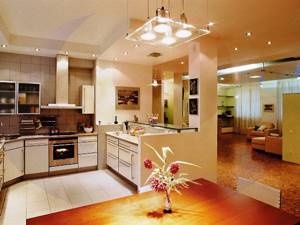
A modern kitchen, even with a powerful stove, does not consume much electricity.
The approximate cost of cooking with electricity will be from 300 to 500 rubles per month, regardless of the size of your home.
An example of a real system with an intelligent control circuit for electric heating at home
NOBO, a leading European manufacturer of convectors, produces two compatible systems for “smart” control of electrical appliances. Including “warm floors” (via a thermostat) and any other household appliances that are connected to the network (via a panel, a “break” in the circuit or turning on/off sockets). To do this, they produce special thermostats, socket receivers and hidden-mounted relay receivers.
Using such a system, you can monitor and manage the operation of up to 100 devices or group zones. And 700 series thermostats provide 4 operating modes for convectors: comfortable, economical, non-freezing (air temperature 7°C) and “off”. According to the manufacturer, the flexibility of such a control system for convectors and heated floors allows you to save up to 25% on electric heating at home.

One of two control schemes for a multi-zone electrical system Source stroydoma74.ru
Principle of operation
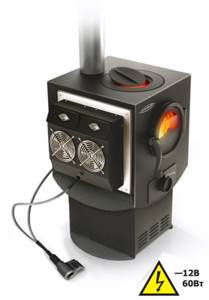
The operating principle of stoves operating on wood and electricity is based on the possibility of automatically turning on electric heating elements when the temperature drops (after solid fuel burns out). This happens as follows:
- Kindling and heating of the stove is carried out using firewood. Since the firebox is located at the bottom of the device, it transfers heat from the burning wood to the upper part of the device - to the heat exchanger. An increase in coolant temperature is detected by a sensor installed in the system line;
- when the temperature begins to drop due to fuel burning, the electrical circuit is automatically closed and electric heaters are connected to operation;
- from this moment on, the specified coolant temperature parameters are maintained by the heating elements, based on the readings of the air or water sensor;
- when loading the next batch of solid fuel, the electrical part is automatically switched off, as the coolant is heated
- already from the side of the combustion chamber.
This transition from wood heating to electric heating and vice versa ensures continuous heating of water in the heat exchanger, which allows you to maintain the optimal temperature in the house around the clock.
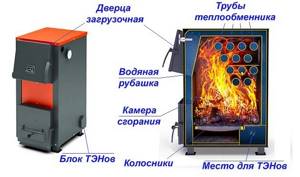
Wood and electric stoves come in two types:
- single-circuit - connected to the heating system and used only for heating;
- double-circuit - designed to heat the coolant in the heating system and hot water for domestic needs.
Selection of thermal appliances
For autonomous electric heating
Direct heating installations use infrared long-wave emitters, which can be controlled by thermostats that redistribute the load on electrical networks.
For connoisseurs of a pleasant environment, the consumer market offers electric heating
wall, ceiling and floor versions:
- ceramic, glass, metal panels of various colors;
- baseboard heating module;
- fan heaters;
- water heated floor;
- electric fireplaces;
- electric ovens and much more. Among new models of heaters, thermal film is popular. The heating system easily heats any room, warming it up in a few minutes. The film heat emitter is mounted on a heat-insulating layer. Any floor covering without a rubber base can be laid on thermal film.
